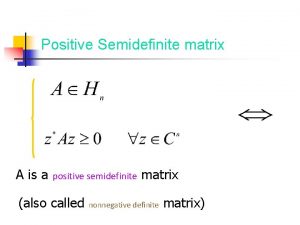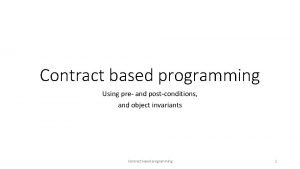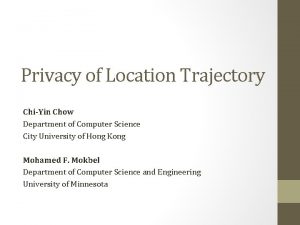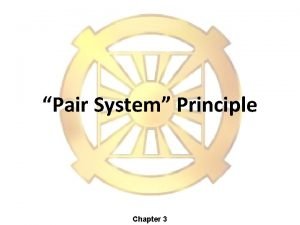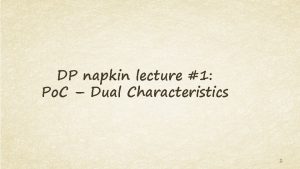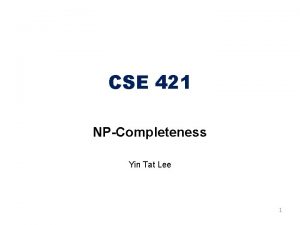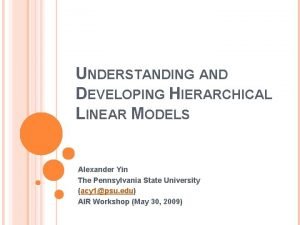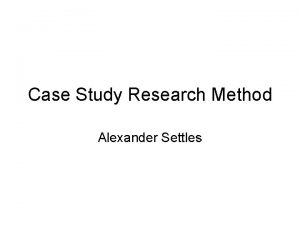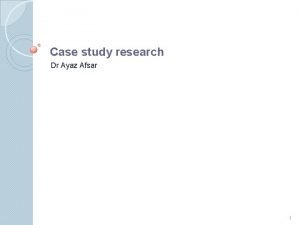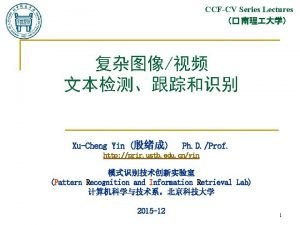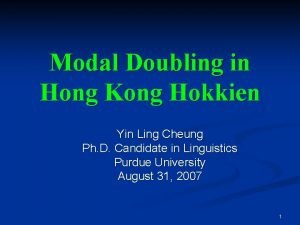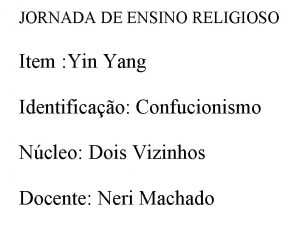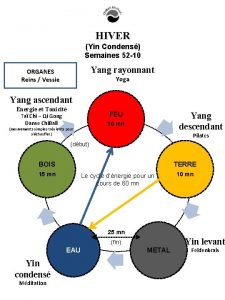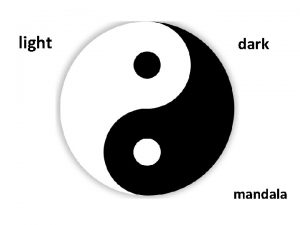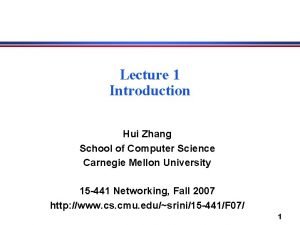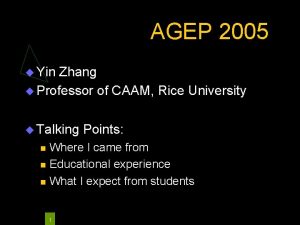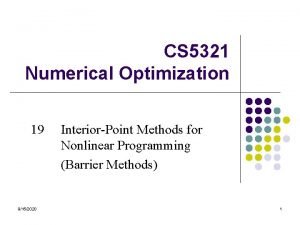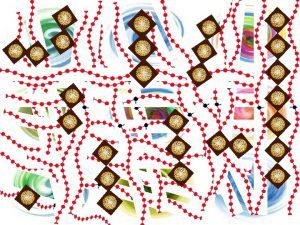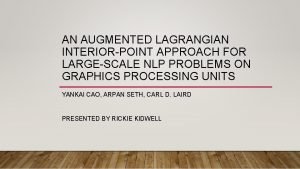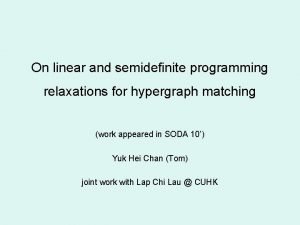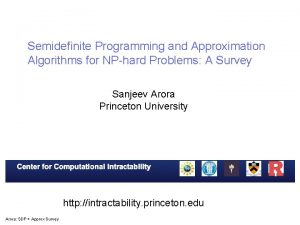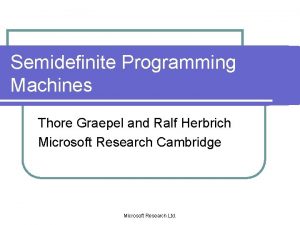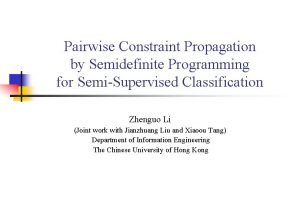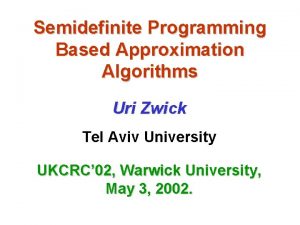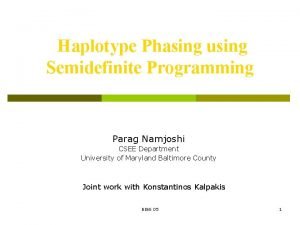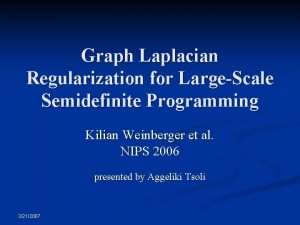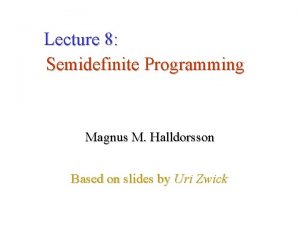InteriorPoint Methods and Semidefinite Programming Yin Zhang Rice









































- Slides: 41

Interior-Point Methods and Semidefinite Programming Yin Zhang Rice University SIAM Annual Meeting Puerto Rico, July 14, 2000 SIAM 00

Outline n n n The problem What are interior-point methods? Complexity theory for convex optimization Narrowing the gap between theory and practice How practical are interior-point methods? This presentation n is focused on a brief overview and a few selected topics n will inevitably omit many important topics and works 07/14/2000 SIAM 00 2

Part 1. The problem n n n Constrained optimization Conic programming They are “equivalent” SIAM 00

Constrained Optimization (CO) The set Q can be defined by equalities and inequalities. Inequalities create most difficulties. 07/14/2000 SIAM 00 4

Conic Programming (CP) n n n CP has a linear objective function Constraint set Q = {affine space} Difficulties hidden in the cone 07/14/2000 SIAM 00 {cone} 5

“Natural” Conic Programs n LP --- nonnegative orthant: n SDP --- semidefinite matrix cone: n SOCP --- second order (ice cream) cone: n Direct sums of the above 07/14/2000 SIAM 00 6

Linear Objective Function W. L. O. G, we can assume f(x)=<c, x>, i. e. , 07/14/2000 SIAM 00 7

Q Affine Space 07/14/2000 SIAM 00 Cone 8

Q Affine Space Cone Hence, CO = CP (theoretically convenient) 07/14/2000 SIAM 00 9

Convex or Nonconvex n Complexity theory exists for convex programs § f and Q are convex, or K is convex § Local minima will all be global 07/14/2000 SIAM 00 10

Part 2: What are Interior-Point Methods? (IPMs)? n n Main ideas Classifications: n n Primal and primal-dual methods Feasible and infeasible methods SIAM 00

Main Ideas: Interior + Newton CP: min{<c, x> : Ax = b, x in K } 1. Keep iterates in the interior of K 2. Apply Newton’s method (How? ) SIAM 00

Newton’s Method n Square Nonlinear systems: n n F(x) = 0 (#equations = #variables) Unconstrained optimization: n n n Equality constrained optimization: n n Sufficient when f is convex 1 st order necessary (KKT) conditions form a square system F(x, y) = 0 Inequality constrained optimization: n n 07/14/2000 KKT system with inequalities How do we apply Newton’s method? SIAM 00 13

Primal IPMs (Barrier Methods) Consider CP: min{<c, x> : Ax=b, x in K } n Solutions are necessarily on the boundary n Barrier function: n Subproblems for t > 0 (equalities only): n n n min {<c, x> +t F(x): Ax = b } x(t) Under suitable conditions, the so-called central path x(t) exists, and as t 0, x(t) x* Newton’s method becomes applicable 07/14/2000 SIAM 00 14

Log-Barriers have a long history n Early works on Log-barrier methods: n n n Frisch 1955 Fiacco & Mc. Cormick, 1968 Murray, Wright, 70 s Convergence results exist (e. g. x(t) x* ) No computational complexity results Modern complexity theory for IPMs: n n n 07/14/2000 Karmarkar on LP, 1984 Many authors on LP, QP, LCP, SDP General theory: Nesterov and Nemirovskii, 1993 SIAM 00 15

Primal and Dual Conic Programs n Primal and Dual CPs: (P): min { <c, x>: Ax = b, x in K } (D): max { <b, y>: A*y + s = c, s in K* } where A* is the adjoint of A , n < Ax, y > = < x, A*y > and K* is the dual cone of K , n n Weak Duality holds: 07/14/2000 SIAM 00 16

Primal-Dual IPMs n They solve the primal and dual together Most efficient in practice n First proposed for LP (Kojima/Mizuno/Yoshise 1990) n n They require strong duality: n n 07/14/2000 < c, x* > = < b, y* > Strong duality holds under reasonable conditions for the usual cones (LP, SDP, ……) SIAM 00 17

Semidefinite Programming (SDP) n n Optimization over matrix variables Applications: n n 07/14/2000 Systems and Control theory, statistics Structural (truss) optimization Combinatorial optimization ………… SIAM 00 18

SDP (continued): n Optimality conditions: X, S in K n n Primal-dual methods for SDP: n n n Primal feasibility: A(X) – b = 0 Dual feasibility: A*(y) + S – C = 0 Complementarity: XS = 0 Keep X, S in K (positive definite) Perturb and apply Newton to equalities Keep an eye on the P-D central path (X(t), y(t), S(t)) 07/14/2000 SIAM 00 19

An SDP Complication n The system is non-square A(X) – b = 0, A*(y) + S – C = 0, XS – t. I = 0 n Many remedies: n n n Helmberger/Rendl/Vanderbei/Wolkowisz, Kojima/Shida/Hara, Monteiro, Nesterov/Todd, Alizahde/Haeberly/Overton, …… Polynomial complexity bounds established A unification scheme: (Monteiro, YZ, 1996) 07/14/2000 SIAM 00 20

IPMs: Feasible vs. Infeasible CP: min{<c, x> : Ax = b, x in K } We already require iterates to stay in K. How about the affine space? n Feasible IPMs: n n n Require iterates to stay in the affine space Easier to analyze, stronger results Infeasible IPMs: n n 07/14/2000 Not require iterates to stay in the affine space Easier to implement, more practical SIAM 00 21

Feasible and Infeasible IPMs CP: min{<c, x> : Ax = b, x in K } e. g. , 3 x+y+2 z = 1, K = {(x, y, z) >= 0} 07/14/2000 SIAM 00 22

Part 3: Complexity theory for convex programming n n n Two wings make IPMs fly: In theory, they work great In practice, they work even better SIAM 00

Theory for Primal IPMs n For t 0, apply Newton’s method to: min { <c, x> + t F(x) : Ax = b } n F and K hold the keys n n Q 1: What barriers are good for Newton? Q 2: What cones permit good barriers? General theory by Nesterov & Nemirovskii: n A 1: Self-concordant barrier functions n A 2: Essentially all convex cones (that contain a non-empty interior but no lines) 07/14/2000 SIAM 00 24

Self-concordant Barrier Function n Strictly convex function in interior of K : n n n The Hessian F’’ varies slowly (good for Newton) The gradient F’ is bounded in a special norm (implying F’ varies slowly near the central path) They guarantee good behavior of Newton on the function <c, x> + t F(x) for varying t 07/14/2000 SIAM 00 25

Examples n Nonnegative Orthant: n Symmetric, positive semidefinite cone: n Log-barriers are optimal (achieving smallest theta value possible) 07/14/2000 SIAM 00 26

Complexity Results for Primal IPMs (N&N 1993, simplified) n n Assume Worst-case iteration number for short-step methods n n : long-step methods Different strategies exist to force t 0 A gap exists between theory and practice 07/14/2000 SIAM 00 27

Elegant theory has limitations n n n Self-concordant barriers are not computable for general cone Polynomial bounds on iteration number do not necessarily mean polynomial algorithms A few nice cones (LP, SDP, SOCP, …) are exceptions 07/14/2000 SIAM 00 28

General Theory for Primal-Dual IPMs (Nesterov & Todd 98) n Theory applies to symmetric cones: n n n n Convex, self-dual (K = K*) , homogeneous Only 5 such basic symmetric cones exist LP, SDP, SOCP, …, are covered Requires strong duality: <c, x*> = <b, y*> Same polynomial bounds on #iterations hold Polynomial bounds exist for #operations A gap still exists between theory & practice 07/14/2000 SIAM 00 29

Part 4: Narrowing the Gap Between Theory and Practice n n Infeasible algorithms Asymptotic complexity (terminology used by Ye) SIAM 00

Complexity of Infeasible Primal-Dual algorithms: n n All early complexity results require feasible starting points (hard to get) Practical algorithms only require starting points in the cone (easy) Can polynomial complexity be proven for infeasible algorithms? Affirmative answers would narrow the gap between theory and practice 07/14/2000 SIAM 00 31

The answers are indeed affirmative n n For LP: YZ 1992, also for SDP: YZ 1996 Numerous works since 1992 Polynomial bounds are weaker than feasible case There are many infeasible paths in the cone, e. g. , 07/14/2000 SIAM 00 32

Asymptotic Complexity n n Why primal-dual algorithms are more efficient than primal ones in practice? Why long-step algorithms are more efficient than short-step ones in practice? Traditional complexity theory does not provide answers An answer lies in asymptotic behavior (i. e. , local convergence rates) 07/14/2000 SIAM 00 33

IPMs Are Not Really Newtonian n n n Nonlinear system is parameterized Full steps cannot be taken Jacobian is often singular at solutions Can the asymptotic convergence rate be higher than linear? Quadratic? Higher? Affirmative answers would explain why far less iterations taken by good algorithms than predicted by worst-case bounds A fast local rate accelerates convergence 07/14/2000 SIAM 00 34

Answers are all affirmative n LP: Quadratic and higher rates attainable n n 07/14/2000 YZ/Tapia/Dennis 92, YZ/Tapia 93, YZ/Tapia/Potra 93, Ye/Guler/Tapia/YZ 93, Mehrotra 93, YZ/D. Zhang/96, Wright/YZ 96, …… Extended to SDP and beyond IPMs can be made asymptotically close to Newton method or composite Newton methods Idea: fully utilizing factorizations SIAM 00 35

Part 5: Practical Performance of IPMs n n Remarkably successful on “natural” CPs IPMs in Linear programming: n n n Now in every major commercial code Brought an end to the Simplex era SDP: enabling technology Are there efficient interior-point algorithms for general convex programs in practice? How about for nonconvex programs? 07/14/2000 SIAM 00 36

Nonlinear Programming KKT conditions form a nonlinear system with non-negativity constraints Interior-point framework: n n 07/14/2000 Perturb and Apply Newton Keep iterates in the cone SIAM 00 37

KKT system and Perturbation Optimality (KKT) conditions: Perturb KKT, then apply Newton n Hopefully, (x(t), y(t), z(t)) (x*, y*, z*) (There is a close connection to log-barrier) n 07/14/2000 SIAM 00 38

Does it work? n General convex programming: n n n Yes, provided that derivatives are available and affordable Global convergence can be established under reasonable conditions (but not poly. complexity) (e. g. El-Bakry/Tsuchiya/Tapia/YZ, 1992, ……. ) Nonconvex programming: n n 07/14/2000 Yes, locally speaking (local optima, local convergence) Continuing research (Session MS 68 today) SIAM 00 39

Recent Books on IPMs n n n Nesterov and Nemirovskii, “Interior Point Methods in Convex Programming”, SIAM 1993 Wright, “Primal-Dual Interior Point Methods”, SIAM, 1997 Ye, “Interior Point Algorithms: Theory and Analysis”, John Wiley, 1997 Roos/Terlaky/Vial, ” Theory and Algorithms for Linear Optimization: An Interior Point Approach” , John Wiley, 1999 Renegar, “Mathematical View of Interior Point Methods in Convex Programming”, SIAM, 2000 Also in many new linear programming books 07/14/2000 SIAM 00 40

A 15 -line MATLAB code for LP min {<c, x >: Ax = b, x >= 0 } t 0=cputime; [m, n]=size(A); x= sqrt(n)*ones(n, 1); y=zeros(m, 1); z = x; p = symmmd(A*A'); bc = 1 + max(norm(b), norm(c)); for iter = 1: 100 Rd=A'*y+z-c; Rp=A*x-b; Rc=x. *z; residual=norm([Rd; Rp; Rc])/bc; fprintf('iter %2 i: residual = %9. 2 e' , iter, residual); fprintf('tobj=%14. 6 en' , c'*x); if residual<5. e-8 break; end; gap=mean(Rc); Rc=Rc-min(. 1, 100*gap)*gap; d=min(5. e+15, x. /z); B = A*sparse(1: n, d)*A'; R = cholinc(B(p, p), 'inf'); t 1 = x. *Rd -Rc; t 2 = -(Rp + A*(t 1. /z)); dy = zeros(m, 1); dy(p)=R(R't 2(p)); dx=(x. *(A'*dy)+t 1). /z; dz=-(z. *dx+Rc). /x; tau = max(. 9995, 1 -gap); ap = -1/min( dx. /x), -1); ad = -1/min(dz. /z), -1); ap = tau*ap; ad = tau*ad; x = x + ap*dx; z = z + ad*dz; y = y + ad*dy; End fprintf('Done!t[m n] = [%g %g] t. CPU = %gn' , m, n, cputime-t 0); 07/14/2000 SIAM 00 41
 Sigular matrix
Sigular matrix Linear programming models graphical and computer methods
Linear programming models graphical and computer methods A-wax pattern recognition
A-wax pattern recognition Contract based programming
Contract based programming Perbedaan linear programming dan integer programming
Perbedaan linear programming dan integer programming Greedy vs dynamic programming
Greedy vs dynamic programming System programming vs application programming
System programming vs application programming Linear vs integer programming
Linear vs integer programming Perbedaan linear programming dan integer programming
Perbedaan linear programming dan integer programming Yin yang marketing
Yin yang marketing Chi-yin chow
Chi-yin chow Yin characteristics
Yin characteristics O'yin turlari slayd
O'yin turlari slayd Savodga o'rgatish
Savodga o'rgatish Meridianos yin
Meridianos yin Yin e yang masculino e feminino
Yin e yang masculino e feminino Yin energy characteristics
Yin energy characteristics Yin tat lee
Yin tat lee Yin yang fish dish
Yin yang fish dish Alexander yin
Alexander yin Slidetodoc.com
Slidetodoc.com Wenyan yin
Wenyan yin Robert yin case study
Robert yin case study Case study yin
Case study yin Teoria yin yang
Teoria yin yang Huai yan jav
Huai yan jav Yin
Yin Junqi yin
Junqi yin Nanna gillberg
Nanna gillberg Yin
Yin Simbolo taoismo
Simbolo taoismo Wong wai yin
Wong wai yin Muskul tuzilishi
Muskul tuzilishi Cheung yin ling
Cheung yin ling Yin significado
Yin significado Yin deficiency
Yin deficiency Méridien vessie
Méridien vessie Dark mandala
Dark mandala Yan7
Yan7 Qirun zhang
Qirun zhang Hui zhang cmu
Hui zhang cmu Zuofeng zhang
Zuofeng zhang
